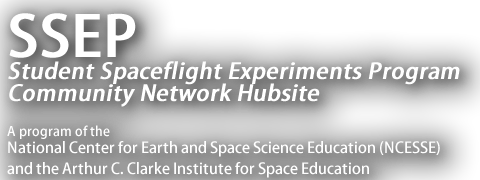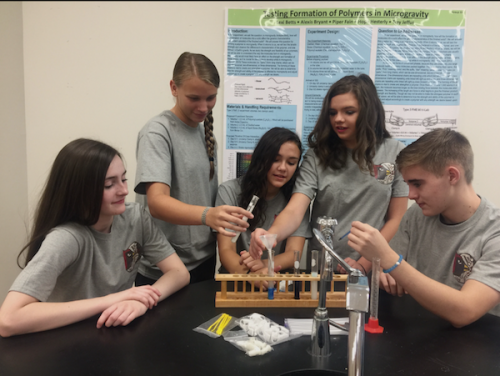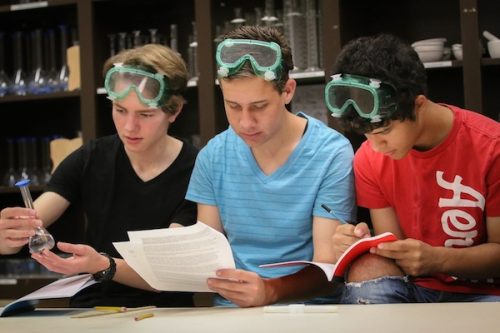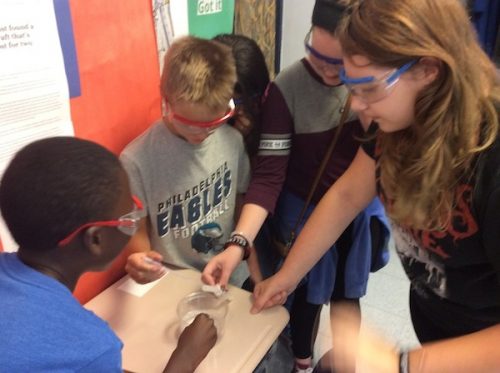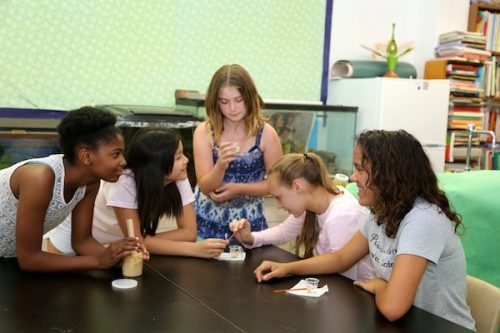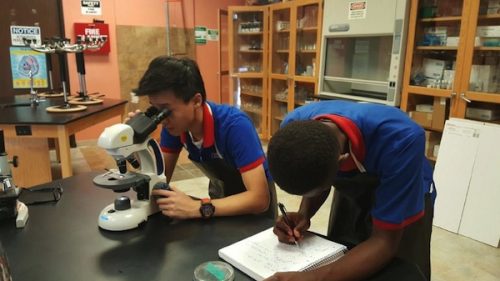The Student Spaceflight Experiments Program is proud to report that there were a total of 685 proposals submitted from student teams across the 11 communities participating in Mission 10 to ISS. Of those, 227 proposals were forwarded for review by Step 1 Review Boards in each of the communities. Each Step 1 Review Board selected three finalist proposals, which were submitted to the National SSEP Step 2 Review Board.
On May 16, 2016, the Step 2 Review Board met at the Smithsonian National Air and Space Museum, reviewed all 33 finalist proposals, and selected one proposal to fly for each community, for a total of 11 flight experiments. By June 1, 2016, the National Center for Earth and Space Science Education and the Arthur C. Clarke Institute for Space Education formally notified each community of their selected flight experiments.
It is noteworthy that the 685 proposals received reflected a total of 3,660 grade 5-16 students fully engaged in experiment design.
All 33 finalist experiment teams, along with descriptions of their proposed flight experiments, are provided below. You are also invited to meet the SSEP Step 2 Review Board members for Mission 10 to ISS.
Congratulations to the nearly 4,000 students and their teachers participating in Student Spaceflight Experiments Program Mission 10 to the International Space Station.
1. Camden, Arkansas
Jump to Camden’s Community Profile
SELECTED FOR FLIGHT:
Testing the Formation of a Polymer in Microgravity
Grade 9, Camden Fairview High School, Camden Fairview School District
Co-Principal Investigators: Lexi Betts, Alexis Bryant, Piper Fain, Hope Hesterly, Trey Jeffus
Teacher Facilitators: Hannah O’Dell, Pam Vaughan
Proposal Summary:
In our project we intend to answer the following question: In microgravity, how will the formation of molecules into a solid affect the general characteristics of the finished solid? In order to answer this question, we will create a polymer comprised of liquid Borax, distilled water, and polyvinyl acetate. These ingredients are able to be shaken and mixed without heat or extensive effort, and harden into a polymer. We will conduct this experiment in microgravity and gravity, and then compare the two resulting polymers. After the polymer is created on the International Space Station and returned to us, we will observe the difference in its general characteristics, such as appearance, buoyancy in water, and tensile strength. By observing and testing, we will record the general differences in said characteristics of the two polymers. We have permission to test the tensile strength in lb/in² of both polymers tested by using an Electro Hydraulic Testing Machine, which is owned and operated by Lockheed Martin Missiles and Fire Control, Camden Arkansas Operatives. Knowing how these molecules react and form their chains in microgravity could give us access to a wide range of knowledge on molecules and how they behave when they lack the amount of gravity we have on Earth. In conclusion, the conduction of this experiment could possibly reveal many things that we do not know about polymers formed in microgravity.
HONORABLE MENTION FINALISTS:
Daphnia Development in Microgravity
Grade 11, Camden Fairview High School, Camden Fairview School District
Co-Principal Investigators: Tim Crumpler, Haley Ezell, Justin Thibault
Advisor: Dr. Tim Knight, Ouachita Baptist University
Teacher Facilitators: Hannah O’Dell, Pam Vaughan
Proposal Summary:
The experiment described in this proposal will test how microgravity affects the development of Daphnia magna water fleas. A recent scientific study was conducted with microarrays to test the gene expression of Daphnia magna when developed under different stressors incorporated in their environment. Our experiment will be an extension of this study as this experiment will test the gene expression of the Daphnia magna when developed with a microgravity stressor incorporated into the environment in which they develop. Identical experiments will be conducted in both gravity and microgravity environments and then examined side by side for differences in gene expression between the two samples.
Starving for More
Grade 9, Camden Fairview High School, Camden Fairview School District
Co-Principal Investigators: Gabrielle Fife, Alex Long, Tykira Manago, Marqavious Kilgore
Teacher Facilitators: Hannah O’Dell, Pam Vaughan
Proposal Summary:
In our experiment we will be observing the bacteria Clostridium thermocellum. We chose this bacteria because it is able to easily adjust to the environment around it. Clostridium thermocellum is an anaerobic bacteria that strives in hot areas, making it thermophilic. Because it is also a spore-forming bacteria, Clostridium thermocellum it is able to grow endospores. Clostridium thermocellum can become dormant if the living conditions are not ideal for it. We want to see if microgravity will cause Clostridium thermocellum to form endospores. Our experiment will consist of starving the Clostridium thermocellum while it is in microgravity then using a freezing agent to stop any growth or development. To determine endospore formation we will perform an endospore stain in both samples prior to launching our flight experiment and compare results to an endospore stain to be performed once the experiment returns to Earth. Clostridium thermocellum is used in making ethanol, and if we are able to find a way to grow the bacteria faster in microgravity this could lead to major advances in the world’s ethanol supply. The bacteria is capable of breaking down cellulose into ethanol, which is vital to biomass energy. This means that, if our experiment is a success, we may be able to increase the amount of ethanol produced.
2. Elk Grove, California
Jump to Elk Grove’s Community Profile
SELECTED FOR FLIGHT:
Does the Structure of a Fairy Shrimp Change in Microgravity?
Grade 5, C.W. Dillard Elementary School, Elk Grove Unified School District
Co-Principal Investigators: Dulcemaria Rodriguez, Josue Escobar, Mason Maroney, Sean Rowing
Teacher Facilitator: Mike Nelson
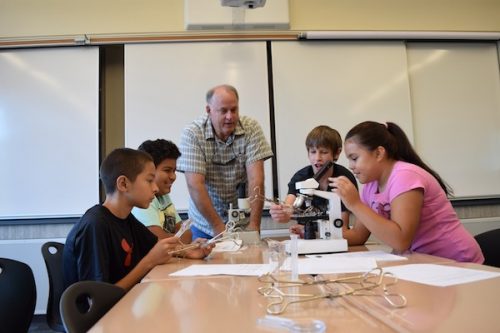
C.W. Dillard Elementary School scientists Mason Maroney, Josue Escobar, Teacher Mike Nelson, Sean Rowing and Dulcemaria Rodriguez analyze the first in a series of trials testing the hatch rate and growth of fairy shrimp.
Proposal Summary:
We propose the question does the structure of a fairy shrimp [Anostraca] on Earth change in microgravity? Our team is wondering if fairy shrimp will change if it is grown in microgravity. We want to know if the structure of a fairy shrimp will be normal or will it be deformed. We are planning to use 25 fairy shrimp cysts. Since the structure of a fairy shrimp on earth is made for gravity we are questioning if the structure of the fairy shrimp grown in space will be weaker than of those of Earth. Our hypothesis is that the fairy shrimp grown on earth is going to be stronger and bigger than the fairy shrimp grown in space. Since there is no gravity in space the fairy shrimp won’t have to use their body as much and won’t build up muscles. If fairy shrimp grows and matures normally then other invertebrates can grow normally and some of those invertebrates we can eat. In the end we will look for abnormalities in the fairy shrimp grown in space.
HONORABLE MENTION FINALISTS:
How is Fage Greek Yogurt’s Bacteria Reproduction Rate and Nutrition Affected in Microgravity?
Grade 5, C.W. Dillard Elementary School, Elk Grove Unified School District
Co-Principal Investigators: Jasroop Gill, Lilah Gonsalves, Luke Panttaja
Teacher Facilitator: Mike Nelson
Proposal Summary:
Greek yogurt is one of the healthiest types of yogurt in the world. We plan to study how microgravity affects the bacteria reproduction rate in Greek yogurt and its nutritional value. Astronauts need to eat in the International Space Station (ISS). Steak and other sources of protein are difficult to pack and prepare. Yogurt would be a great idea, it wouldn’t take up much space and needs no preparation. Yogurt has lots of nutrition in one cup. Yogurt also has plenty of protein which is great for strengthening muscles and bones. Yogurt helps your intestinal health and contains good gut bacteria. Greek yogurt has 1 cup of protein, making it a healthier alternative to whole milk yogurt which has 8.5 grams of protein. Greek yogurt also has less sugar than other yogurts. Greek yogurt is rich in many minerals and contains active bacteria, including B12, B2, Selenium, Phosphorus, Calcium, Zinc, B6, B5, and other minerals astronauts need to stay healthy. B12, can help lower risk of breast, colon, lung, and prostate cancer. Our research tells the reasons why yogurt should be tested in space. Yogurt is a fantastic way for astronauts to get the nutrition they need. Not only is it nutritious, it is compact, easy to store, and easy to prepare. If yogurt’s live bacteria count stays the same or grow it will be much better to eat than any other food source and the astronauts will function better after eating the Greek yogurt.
Litmus Paper Color Dynamics
Grade 5, Arnold Adreani Elementary School, Elk Grove Unified School District
Co-Principal Investigators: Pavit Chahal, Nicholas Giang, Tyler Pham, Jackson Scarbrough, Huy-An Tran
Teacher Facilitator: Ann Scheer
Proposal Summary:
Our proposal is to find out if microgravity affects the color of blue litmus paper. We will use the acid, lemon juice, for this experiment. Once the clamp is released at microgravity, the litmus paper will absorb the lemon juice. Then, if the litmus paper turns red, the results will be the same as it is on Earth. If there is no reaction and or the litmus paper changes to a different color, the result would differ from Earth’s effect. In conclusion, our proposal will help determine if microgravity affects the color on blue litmus paper when exposed to an acid.
3. iLEAD Consortium, California
Jump to iLEAD Consortium’s Community Profile
SELECTED FOR FLIGHT:
The Effects of Microgravity on Oxidation
Grade 11, Santa Clarita Valley International Charter School, William S. Hart Union High School District
Co-Principal Investigators: Dustin Fields, Alec Lewis, Kai Turner
Teacher Facilitator: Zaloa Goiri Virto
Proposal Summary:
In our experiment, we will be observing the effects of microgravity on the formation of iron oxide. Iron (III) Oxide (Fe2O3) forms when oxygen and water react with iron to create a brittle, crusty, and often reddish orange substance commonly referred to as “rust”. We chose this topic because steel, an iron alloy, is a commonly used material for space exploration. Non stainless steel is prone to rusting. For our experiment we will be using a Type 2 FME. In Volume 1, we will place a 3mm x 65mm rod of iron into the stopper on the Volume 1 side of the FME and secure it using epoxy. In Volume 2 we will have 2 ml of distilled water. Once our experiment has come back to earth, we will conduct three different tests and compare the results to our ground level truth experiment. The first of these tests involves observing rust under a microscope to determine any obvious structural differences. We will also be comparing the frangibility of the two samples. Our third test will be looking at how much rust grew in comparison to our control and how deep the rust penetrated into the iron rod. With the data we collect post flight, we hope to further our understanding of the formation of iron oxide in a microgravity environment. By studying and directly comparing earth and space grown iron oxide, we hope to provide insight on oxidation in microgravity conditions and further the study of materials used in space.
HONORABLE MENTION FINALISTS:
Can Annelid Worm Eggs Hatch in Microgravity?
Grades 9-10, iLead Innovation Studios AV, William S. Hart Union High School District
Co-Principal Investigators: Cleopatra Casillas, Shelby Cooper
Collaborators: Eriq Aquino, Austin Chapa, Shayla Smiley
Teacher Facilitator: Kelly Clark
Proposal Summary:
Improvements in launch, power, and computer systems have improved safety and reliability, as well as reduced cost for space exploration. However, we have not improved in the human waste removal system. Solid waste is not being used as a resource, and is being put into a departing cargo vehicle. Adding a recycling process, the cultivation of annelid worms, or vermiculture to the system could benefit the colonization of other planets by producing nutrients for crop cultivation. The first step would be to determine if vermiculture is a viable operating process by investigating if annelid worms or earthworms, the organisms that produce the nutrients, can survive in microgravity (mG). Earthworms have a life cycle that includes cocoon, hatching, juvenile, and adult stages. Our hypothesis is to determine if the cocoons can hatch in Low Earth Orbit (LEO). It is important to study the beginning life cycle of worms because we will need them to complete their life cycle on site. Encapsulated Earthworm CocoonsTM will be placed in volume 2 of the Fluids Mixing Enclosure (FME), with water in volumes 1 and 3 as the activating fluid. The astronaut will unsecure Clamps A and B, breaking the seal and releasing the water. The water should dissolve the clay encapsulation, and soften the cocoon shells. If the hypothesis is true, then it would be beneficial to continue with the advancement of vermiculture experiments. This could lead to the future development of a sustainable and dependable food source system for astronauts.
The Efficacy of Biocence in a Microgravity Environment
Grade 8, Santa Clarita Valley International Charter School, William S. Hart Union High School District
Co-Principal Investigators: Sean Brimigion, Ethan Guthrie, Austin Horner, Jaron Steele
Advisors: Allan Lord, Biocence Technology; Rich Ulrich, Biocence Technology; Micro Quality Labs, Inc.
Teacher Facilitator: Kathleen Fredette
Proposal Summary:
Our experiment will examine the efficacy of Biocence in a microgravity environment. Biocence is an all-natural liquid substance that kills all harmful organisms tested to date. These include common things like bacteria, viruses, mold, and fungi. The Center for Disease Control rates these under a Biosafety Level (BSL), which categorizes the organism’s level of danger. Biocence has proven effective across all BSL-level organisms, including levels 1 through 4; 1 being the least dangerous and 4 being the most. On Earth, Biocence eradicates harmful organisms within thirty seconds of introduction, without harm to healthy cells. Given that travel to Mars is close at hand, our goal is to ensure the safety of long-term space travel. If Biocence extinguishes bacteria in microgravity, it will increase the safety of the participants on any given spacecraft. We feel this is of immense importance, as does Congress, having passed House Bill 2262, which includes a clause that states, “Department of Transportation shall continue to work…to improve the safety of crew, government astronauts, and spaceflight participants as that sector continues to mature.” We will compare the amount of bacteria that Biocence eradicated in Earth’s gravity to the amount that was eradicated in microgravity. We will use the FME lab #2, which includes two sections: one for Escherichia coli (E. coli), which is our choice of bacteria, and the other for Biocence.
4. Lennox, California
Jump to Lennox’s Community Profile
SELECTED FOR FLIGHT:
Benefits of Mint
Grade 8, Lennox Middle School, Lennox School District
Principal Investigator: Nayeli Salgado
Investigator: Kaetlyn Gaeta
Collaborators: Ernesto Bueno, Marina Pimentel
Teacher Facilitator: Celina Morales
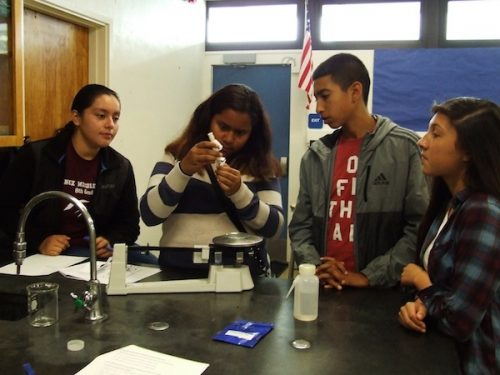
Lennox Middle School Flyers: Nayeli Salgado, Marina Pimetel, Ernesto Bueno, and Kaetlyn Gaeta conducting a preliminary test of their experiment’s materials and volumes.
Proposal Summary:
Have you thought how microgravity might affect the growth of a mint plant? Our team will like to experiment on the growth of a mint plant on Earth and in microgravity. Our hypothesis is that the mint plant will grow faster in microgravity than on Earth. We believe that the height of the mint plant will be taller in microgravity than on Earth. The reason why we want to conduct this experiment is because mint is a medical herb that cures aches. If the growing of mint is successful in microgravity, then we will have the benefit of helping astronauts when they get sick or have pain. Mint also has many impressive medical reliefs. It relieves muscle aches, joint aches, stomachaches, headaches, and toothaches. You can use mint for tea to cure coughs and colds. The scent is also very helpful for nausea and fainting. Mint can be a great help for astronauts in case of an emergency or an unexpected injury. Mint is a fast growing plant, for that reason we chose to test this mint plant in microgravity. Our team knows that mint plant can be a good help if it grows. We think that this experiment is something that can have a great benefit. Mint is a plant that is very helpful instead of just being helpful on Earth it also be helpful in microgravity. We would really like the opportunity to make our experiment be tested in microgravity and see if our hypothesis was correct.
HONORABLE MENTION FINALISTS:
Bread Mold
Grade 8, Lennox Middle School, Lennox School District
Co-Principal Investigators: Amy Fonseca, Hailey Casillas
Investigator: Richardo Rizo
Teacher Facilitator: Celina Morales
Proposal Summary:
In this experiment we will test the growth of mold on bread. We will see if microgravity will affect or not affected the growth process of the mold. In the test tube we will send two different types of bread. One type of bread we are using is white bread we will only put 1/12 of the bread and another type of bread is wheat bread also we will only use 1/12 of the bread as well. We will dip the 1/12 of the bread in soapy water to create the reaction. This experiment has not exactly been sent to space but it has accidently been found in a research project from NASA space station. An astronaut from NASA, Kjelle Lindgren noted that water was seeping out of some wicks – the white flaps that contain the seeds and stick out of the tops of the plant pillows. The water partially engulfed three of the plants. Within 10 days, scientist noted mold on leaves of some plants. This means that they didn’t mean to find the mold but finding the mold was an incredible observation. We are conducting this experiment because we want see how long and fresh stable whole food will last with moist or other objects in it atmosphere. Instead of giving the astronauts process food baggie but whole healthy food. This mini-lab will just be the beginning for the future. Its not too early to start experimenting how long food will stay fresh in space.
How Fast Does Steel Rust in Space?
Grade 8, Lennox Middle School, Lennox School District
Co-Principal Investigators: Jennifer Hernandez, Lizeth Valdovinos
Teacher Facilitator: Celina Morales
Proposal Summary:
How does microgravity affect how fast steel can rust in space? We will compare the amount of rusting on a steel nail in space compared to the amount of rusting on a steel nail on Earth. In order for steel to rust oxygen is needed to complete the process of rusting. We believe that the steel nail will take longer to rust in space since there is less oxygen than there is on Earth. We will compare the amount of rusting on both nails by measuring the rust that was developed on each nail with a ruler. This can be helpful to people who work in outer space because if steel takes a long time to rust, this means that they can use this material to build things in outer space and not worry that they will rust and get damaged. For this experiment we will use the type 2 FME which includes only one clamp in the middle of the tube. On the right side of the tube we will put water and on the left side of the tube we will put the steel nail.
5. Middletown, Delaware
Jump to Middletown’s Community Profile
SELECTED FOR FLIGHT:
Growth and Development of Fathead Minnows in Microgravity
Grade 6, Everett Meredith Middle School, Appoquinimink School District
Co-Principal Investigators: Alivia Alessandrini, Kainat Azhar, Olivia Court, Noah Keller, Moulai Nije
Teacher Facilitator: Meredith Swartzendruber
Proposal Summary:
The main purpose of our experiment is to find out how the fathead minnows thrive in a habitat completely different than their ancestors. We chose fathead minnows because they have been known to thrive in many different habitats. Also, the fathead minnow is small so they will fit better than the others. Our question to be addressed by the experiment is: Can Fathead minnows develop and grow in space? Can them swim? Will they eat? The experiment addresses the question posed because our experiment is based on how minnows develop and live in space.We will be sending minnow eggs that have not hatched into space.We will see if they are able to hatch and see if they can develop and be able to do everything that they can on Earth.
HONORABLE MENTION FINALISTS:
The Arrival of Oxygen through Algae
Grade 8, Everett Meredith Middle School, Appoquinimink School District
Co-Principal Investigators: Mackenzie Allen, Neillyn Firpo, Anna Hernandez, Hajjar Littles
Teacher Facilitator: Meredith Swartzendruber
Proposal Summary:
The topic of this proposal will be the growth of algae in a micro-gravitational environment. Items used in this project will be heterotrophic algae spores, Alga-Gro water with sugar, and Lugol’s solution. Once the algae have awoken on the international space station, the organism will be grown, to later be compared to algae growth on Earth. On the way back to earth from ISS, the heterotrophic algae will be terminated by Lugol’s solution to stop the algae from continuing to grow and produce oxygen that can be changed by their introduction with the atmosphere. Why does it matter gravity might affect their growth? As the largest producer of oxygen on the planet, any information that can be learned about it in a microgravity environment is essential since scientists are pushing for space exploration. Learning how to produce oxygen in space will be a great part of creating livable domes for humans and plants. By discovering this information, we can create an environment using heterotrophic algae to experiment with how much oxygen is being created in their new environment and by measuring the algae’s growth to know how much can be produced. On the other hand, discovering more about how algae grows in space will reveal more about what elements must be added for an environment to change to adapt to a human environment.
Cabbage Growth Survival in a Microgravity Environment
Grade 6, Everett Meredith Middle School, Appoquinimink School District
Co-Principal Investigators: Kayty Kemoni, Kylee Leverage
Teacher Facilitator: Meredith Swartzendruber
Proposal Summary:
The purpose of the following experiment is to regulate or improve the growth of plants in a microgravity environment successfully. Moreover, the purpose of this simple experiment is also to ascertain if/how the National Aeronautics and Space Administration (NASA) could gain knowledge about agriculture, biology, and Earth’s gravity. While carrying out this experiment we will be using a type 2 FME as well as, water, soil and cabbage seeds within it. The International Space Station (ISS) has been doing experiments in a microgravity atmosphere, known as the Space Garden. There they make many new discoveries. Furthermore, on Earth cabbage is grown all the time by farmers and are grown in mildly or slightly cold climates such as, 60 to 65 degrees, 45 degrees at the lowest and even up to 80 degrees. Additionally, cabbage has been grown on the ISS before, but they discover something new every time.
6. Lansing, Kansas
Jump to Lansing’s Community Profile
SELECTED FOR FLIGHT:
Possible Effects of Microgravity on Development of Dictyostelium discoideum
Grade 7, Lansing Middle School, Lansing Unified School District 469
Co-Principal Investigators: Aaron Brown, Calista McPherson, Vinay Patel, Geoffrey Stentiford
Teacher Facilitator: Stephanie Major
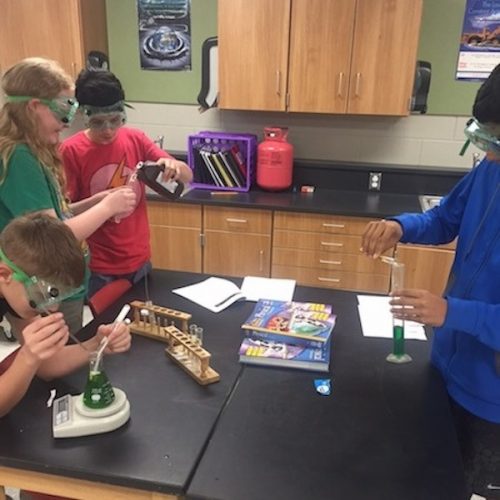
The winning SSEP team from Lansing Middle School in Lansing, Kansas. Clockwise from right: Vinay Patel, Aaron Brown, Calista McPherson, and Geoffrey Stentiford.
Proposal Summary:
This experiment aims to observe the effects of microgravity on the development of D. discoideum, a type of cellular slime mold. D. discoideum can be used to model a human fetus in the early stages of development. This experiment is very simple: The interior of a Type-Two Fluid Mixing Enclosure will be coated with one millimeter of nonnutrient agar; Volume 1 will contain a sample of D. discoideum; Volume 2 will also contain a small colony of E. coli bacteria, which will be grown on Earth prior to launch, to provide food for the slime mold. Once in space, the clamp will be opened, and the amoebas will venture out and feed on the bacteria. However, the bacteria will not have a food source, and will stop multiplying. As a result, the D. discoideum will also run out of their food, the bacteria. This starvation will trigger the reproductive cycle where the individual amoebae aggregate and form a slug for migration and eventually into a spore-releasing stalk. During the early stages of this process, the mound of cells is very similar to a human fetus in early development. Observing this process will allow observation of any possible effects of microgravity on human reproduction in space for long, interplanetary or even interstellar missions.
HONORABLE MENTION FINALISTS:
Sodium Retention
Grade 8, Lansing Middle School, Lansing Unified School District 469
Principal Investigator: Sarah Wilson
Co-Investigators: Leighann Crutchfield, Grace Slattery
Teacher Facilitator: Corinna Lee
Proposal Summary:
The body automatically results in salt intake. Though, too much can cause major damage and our bones would need extra care. Knowing how salt water can affect our bodies physically can help us perfect the amount of which we are consuming. Depending on how much is too much and how much is not enough will result in deeper discoveries. Our group will be investigating an experiment in fluid diffusion. We will further explore in sodium retention. We want to know if microgravity changes the rate of saltwater absorption compared to in a gravity environment. Over the period of time our experiment will be staying at the ISS, (cow bone, salt, and water) astronauts are to observe the saltwater transformation to the cow bone. We think the rate of the liquid to be soaked up in a microgravity state would go faster than on Earth. Further examining sodium build up can help us determine if there is any possible procedures that can be taken into consideration while in a microgravity environment to reduce bone destruction. If we can become more familiar with the breakdown of our bones in microgravity, it can lead to us to discovering ways to help restore our energy and prevent more damage than we already know of.
The Growth of a Plant in a Sodium Polyacrylate-Soil Mixture
Grade 8, Lansing Middle School, Lansing Unified School District 469
Co-Principal Investigators: Martayah Mitchell, Molly Romano
Co-Investigators: Jamie Preston, Victoria Valverde
Teacher Facilitator: Corinna Lee
Proposal Summary:
Our investigation proposes the idea that sodium polyacrylates and soil would make watering and growing plants in space more efficient. Sodium polyacrylates can absorb as much as 200 to 300 times its mass in water so when mixed with soil it would keep the soil moist longer than normal. Mixing soil and polymers will not alter the taste or edibleness of the plant that is growing so it is still safe to eat. If you try to water plants in space the liquid will diffuse and not get to the plant. If the polymers and soil mix, the water will not diffuse and more will absorb into the soil.
7. University System of Maryland (USM), Maryland
Jump to USM’s Community Profile
SELECTED FOR FLIGHT:
Bacterial Motility in Microgravity
Grade 15, University of Maryland, College Park
Co-Principal Investigators: Yaniv Kazansky, Aaron Solomon, Garshasb Soroosh
Advisor: Dr. Wade Winkler
Teacher Facilitator: Dr. Kenneth Frauwirth
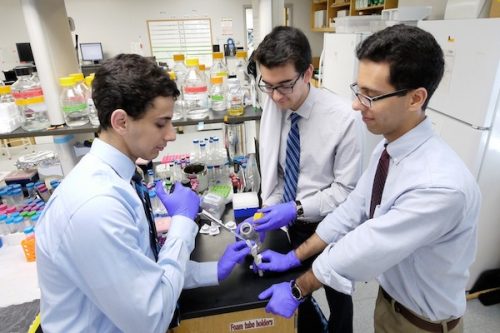
Yaniv Kazansky, Aaron Solomon, and Garshasb Soroosh (left to right) perform a test loading of their fluid mixing enclosure (FME) to optimize the volumes needed in their experiment. Photo credit: Faye Levine, Graphic Designer at UMD CMNS Communications.
Proposal Summary:
Long-term space habitation poses numerous issues for astronaut health, including the prevention and treatment of infectious disease. NASA has made public its concern for the threat posed by infectious bacteria to long-term manned missions, and has conducted experiments on the International Space Station (ISS) to determine how microgravity affects pathogens. This prior research suggests that bacterial motility, a crucial component of many infections, is increased aboard the ISS. Our study seeks to confirm these findings and elucidate which bacterial genes specifically are responsible for modified motility, in the hope of better understanding how disease-causing pathogenic bacteria act in space. We will send dormant bacterial spores of Bacillus subtilis to the ISS, where they will be activated, allowed to grow and divide, and then preserved in microgravity before returning to Earth. We will explore if microgravity causes the bacteria to express (activate or deactivate) their genes differently compared to an identical control sample grown on Earth. This change is recorded in the mRNA produced by the bacteria, and any changes in the number of mRNA molecules and the individual sequence codes of each mRNA strand can be determined using RNA sequencing. The sequence data can then be processed via high-throughput bioinformatic techniques, allowing determination of which bacterial genes are differentially expressed in microgravity, and the molecular pathways that underlie them. This study will shed light on how bacterial motility differs in space, and serve as a critical step in safeguarding astronauts from acquiring infectious disease.
HONORABLE MENTION FINALISTS:
Use of Chlorella vulgaris for Uric Wastewater Bioremediation in Microgravity
Grade 13, University of Maryland, College Park
Co-Principal Investigators: Seth Cohen, Erik Rosenbaum
Teacher Facilitator: Daniel Serrano
Proposal Summary:
Bioremediation is the process of using natural systems to reduce levels of contaminants in polluted resources, like water. Cleaning wastewater with organisms, such as species of greenalgae, is more sustainable and yields fewer harmful products than mechanical and chemical methods of cleaning wastewater. Being able to use bioremediation on board the International Space Station (ISS) could give astronauts a more dependable, longer-lasting water recycling system. The green-algae Chlorella vulgaris has been studied for its ability to lower levels of ammonium, phosphorous, and chemical oxygen demand (COD). This alga is known for its bioremediation abilities, as it has been tested here on Earth for its ability to directly clean wastewater streams. This experiment will examine the effect of microgravity on the ability of C. vulgaris to significantly reduce levels of common indicators of wastewater contamination. We will send a culture of C. vulgaris to the ISS in media that contains the wastewater indicators ammonia, phosphate, and COD. Using the Phenate Method, Ascorbic Acid Method, and Dichromate Method respectively, we will measure the concentrations of each of these indicators both before they are exposed to the algae and after, which will indicate the algae’s ability to perform bioremediation in microgravity. Measuring the bioremediation ability of C. vulgaris will shed light on other possible ways to efficiently and sustainably recycle uric wastewater (wastewater from urine) aboard the ISS. This research will also provide further insight on algal behavior and function in microgravity, as well as the feasibility of long-term space missions.
Investigating Cell Migration Under Microgravity Conditions
Grades 14-15, University of Maryland, Baltimore County
Co-Principal Investigators: Sylvia Edoigiawerie, Kamsi Odinammadu, Amelia Smith, Beverly Wu
Teacher Facilitator: Dr. Michelle Starz-Gaiano
Proposal Summary:
Our project is centered around observing the effects of microgravity on cell migration. Cell migration has a tremendous role in immune function and wound healing since immune cells must mobilize in order to engulf microorganisms. For our project, we use migratory cells in Drosophila melanogaster (D. melanogaster), also known as fruit-flies, as an analogous system to migrating immune cells. Within our system, we focus on a few key proteins. Among them are Actin, Unpaired (Upd) and E-Cadherin. Upd acts as a cytokine, a cell signaling molecule. Literature conducted on inflammatory cytokines under microgravity conditions has led us to believe cytokine levels may be decreased in simulated microgravity conditions. We will investigate if there is a similar effect on Upd in microgravity. In addition, the mechanics of cell migration are largely influenced by both actin dynamics, which control the cytoskeleton that gives the cell structure, and E-cadherin, which allows cells to adhere to surfaces and has stabilizing effects. By conducting immunocytochemistry experiments and counting the number of cells that are able to migrate under microgravity, we hope to de-mystify the effects of microgravity on protein concentration levels and ultimately on cell migration.
8. Clark County, Nevada
Jump to Clark County’s Community Profile
SELECTED FOR FLIGHT:
Soybean Germination in Microgravity
Grade 5, John C. Vanderburg Elementary School, Clark County School District
Co-Principal Investigators: Shani Abeyakoon, Kendall Allgower, Avery Sanford
Teacher Facilitator: William Gilluly
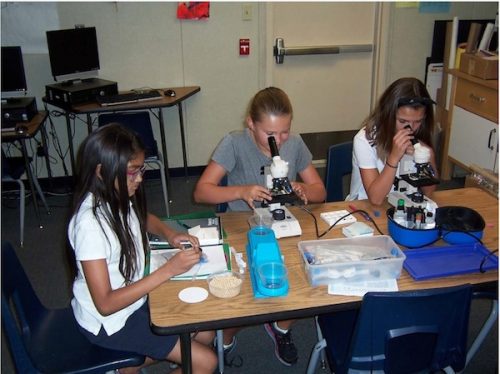
Students conducting a preliminary ground experiment to select the number and variety of Soybean to be used, the amount of distilled water and liquid fertilizer to be included in Volume 1 of the FME. From left to right: Shani Abeyakoon, Kendall Allgower and Avery Sanford.
Proposal Summary:
The question we are asking is: Will microgravity affect the germination and root structure of Soybeans? The human body uses certain organs for support, but in zero-gravity their purpose suddenly isn’t needed as much. In space, the balance between cells that make the bone and the cells that break the bone down become uneven. Calcium and other minerals that build the bones leach out and make the bone weaker. Two hundred fifty grams of Soybeans is 50% of the daily Calcium a person needs. Astronauts lose 1-2% of bone mass each month in space and muscle mass can be lost at rates as high as 5% each week. Soybeans will help reduce muscle and bone loss which is why this project is so important.
HONORABLE MENTION FINALISTS:
Can Mycorrhizae Grow in Microgravity?
Grade 5, William V. Wright Elementary School, Clark County School District
Co-Principal Investigators: Bisrat Hilete, Sabrina Reyes, Athena Wu
Teacher Facilitator: Carron Haggerty
Proposal Summary:
Mycorrhizae is a fungus that helps land plants grow healthy. It bonds to the roots of plants and helps them get more water and nutrients in an exchange for carbohydrates. The mycorrhizae also help to protect the roots of plants and boosts pathogen protection for plants. Our question is: Could mycorrhizae grow in microgravity? Mycorrhizae could be important in space as it is for about 90% of vascular land plants on earth. If we could colonize on Mars or live in other places in space, mycorrhizae would be very useful to help grow plants. If mycorrhizae could survive in microgravity, it could be a big part of growing healthy agriculture for food in space.
Pleurotus Ostreatus Mycelium Growth in Microgravity
Grade 5, Kathy L. Batterman Elementary School, Clark County School District
Co-Principal Investigators: Charlie Buo, Kaiden Hernandez, Tyler Hockersmith, Levi Landers
Teacher Facilitator: Debbie Smith
Proposal Summary:
We propose to answer the question: Will Pleurotus ostreatus (oyster mushroom) mycelium grow in microgravity aboard the International Space Station (I.S.S.)? We want to do this because the oyster mushrooms are a nutritious food source that also can rid soil of pollution. The oyster mushroom is rich in vitamins that include, Vitamin D, and Vitamin C. When eaten, the oyster mushroom helps with bone growth, tissue regeneration, and in maintaining energy. These are vital to maintaining a healthy environment in microgravity. This experiment shall be done by dousing wood chips in oyster mushroom spawn and water. This should begin colonizing the wood chips. We want to see if there are any anomalies in the growth of the mycelium to see if it would be a suitable crop to grow in microgravity. If it is a suitable crop to grow in space missions it will help astronauts work and live in space for longer and more effective amounts of time.
9. Summit, New Jersey
Jump to Summit’s Community Profile
SELECTED FOR FLIGHT:
The Development of Venessa cardui Butterflies in Microgravity
Grades 5 and 7, Kent Place School
Co-Principal Investigators: Olivia Adamczyk, Alexandra Anderson, Isabella Diaz, Nora Lee, Aya Mtume, Abigail Wall, Elizabeth Wyshner
Teacher Facilitator: Rebecca Van Ry
Proposal Summary:
We would like to propose an experiment involving the growth and life cycle of Western Pygmy Blue butterflies in microgravity. We have chosen the Western Pygmy Blue butterfly as the main subject of this experiment because they are the smallest butterfly in the world; that means they will fit into the tube. Gravity plays a part in the metamorphosis process of butterflies because the butterflies have to suspend upside-down in order to pupate correctly. Since there is no up or down in microgravity, the cocoons may have a hard time being able to flourish and grow. If the Western Pygmy Blue butterfly is sent up to space and goes through its life cycle successfully, the knowledge gained may be very beneficial for the growth of plants in space. The butterflies will start in the experiment as eggs because it will take them about 10 days to hatch. This means that they will stay like that for 7-10 days and then they will develop in microgravity. If the butterflies are able to survive in this environment, they could serve as pollinators, leading to healthy seed and fruit production. Plants provide food and also turn carbon dioxide into oxygen which could help oxygen levels for the astronauts on the ISS. On Earth, we are currently observing Painted Lady butterflies, which will give us a sense of the normal life cycle of a butterfly. Sending butterflies up to space could ultimately lead to great gains within future space travel.
HONORABLE MENTION FINALISTS:
Astronauts Feel Things in Their Guts Too: Studying the Effects of Microgravity on Microbial Habitats in the Human Digestive Tract
Grade 9, Kent Place School
Co-Principal Investigators: Tarika Bansal, Isabella Racioppi, Kailee Saunders
Teacher Facilitator: Mr. Cashel
Proposal Summary:
The proposed experiment to be sent into space for observation under microgravity is a Winogradsky column. This could answer what the effects of space travel are on the human digestive tract. A Winogradsky column is a transparent tube filled with soil, water, a carbon source (such as newspaper) for cellulose, and other optional sources of nutrients that results in a visual separation of the contents of into gradients. These gradients form as the microbes move to the places where they receive the optimal amount of light and types of nutrients and they continue to reuse and recycle the nutrients. This process reflects the activity of microbes within the digestive tracts of humans. Similar to the way that the microbes in the Winogradsky column find the right location within it for their needs, those in the human digestive tract have specific locations within it to meet its needs. These microbes are essential to human health and play important roles in the digestion of food. For example, the Lactobacillus species helps to digest food by breaking down lactose and fermenting carbohydrates that the body cannot. In this experiment, the layers will be made in advance and the microbes will be exposed to all of the layers. This will allow for a comparison of the amount of bacteria in each layer between the experiment in microgravity and the control experiment on earth; this will offer a unique understanding of how human beings can adapt to a seeming absence of gravity for extended space travel.
Generation Regeneration: Cellular Activity in Microgravity
Grade 8, Kent Place School
Co-Principal Investigators: Elizabeth Cotter, Erin Green, Adrianna Guarino, Maya Vuchic
Teacher Facilitator: Wendy Hall
Proposal Summary:
Our group would like to propose an experiment regarding cellular regeneration and the effects of microgravity on this experiment. The regeneration of cells manifests differently in all animals, but it plays an especially important role for humans, allowing cuts and wounds to heal relatively quickly and the liver to regenerate. Planarian, a small type of flatworm, reproduce asexually through the process of fission, pinching themselves into two pieces with each piece regenerating into a whole new worm. Our experiment will be to examine the process of Planariann asexual reproduction in both microgravity and gravity environments. We would send four brown Planarian to the ISS in a tube filled with approximately 4.45 mL of spring water. There would be one clamp with a chamber of 10% Neutral Buffered Formalin (NBF) approx. 3.7% formaldehyde in phosphate buffered saline; a Planarian-killing chemical, that will be released before the return trip as a way to stop any further alterations from occurring. The other clamp will contain the organisms main food source and a substance. We will then examine the differences and similarities in both environments. The purpose of our experiment is to test the effects of microgravity on cellular regeneration. Doing this experiment and observing the differences of reproduction in microgravity, as opposed to in gravity, could help scientists figure out exactly what triggers an organism to begin regenerating and maybe even open the doors for humans to harness the power of regeneration for the benefit of themselves.
10. Houston, Texas – Harmony Public Schools
Jump to Houston’s Community Profile
SELECTED FOR FLIGHT:
Role of Gravity in Flatworm Regeneration
Grade 10, Harmony Science Academy Houston High, Harmony Public Schools
Co-Principal Investigators: Ben Appiah, Richard Gomez, Isaiah Ogunmakin, Bassam Razzaq, Matthew Vuong
Teacher Facilitator: Guvanchmyrat Payatakov
Proposal Summary:
We pose the question, how does gravity affect flatworm regeneration? A flatworm is able to regenerate various parts of its body after being completely severed from those parts because of its use of STEM Cells, which have the ability to turn generalized cells into any kind of cells and proliferate, eventually regrowing specific organs or body parts. Thus our team is experimenting to see how much flatworms regenerate in space, a no gravity environment, compared to Earth. The purpose of the experiment is to investigate if regeneration in a no gravity environment is more proficient than an environment with gravity. The insight of this can open new doors for regenerative medicine and health science. As of right now, we have no way of curing terminal diseases or issues like blindness, however, if there is a large advancement in regenerative medicine we could use it to better our technology used to cure diseases such as those. Thus, it would be useful to test how regeneration works in different environments to better understand regenerative medicine.
HONORABLE MENTION FINALISTS:
Human Egg Fertilization in Microgravity
Grade 10, Harmony Science Academy Houston High, Harmony Public Schools
Co-Principal Investigators: Paul De Guzman, Alejandro Valdes Garcia
Teacher Facilitator: Michael Bowling
Proposal Summary:
The goal of this experiment is to study the effects of a microgravity environment on the fertilization of a human ovum (egg cell) by sperm. Current research led by NASA (2001) suggests that gravity has an effect on sperm fertility, regardless of originating species. Both simulated and real microgravity environments have been found to impact fertility in many organisms, with prolonged exposure sometimes even leading to infertility. Thus far, the impact of exposure to low gravity on human reproduction is unclear; experiments have been conducted only on animals, and statistical analysis does not reveal a significant discrepancy in fertility rates for either male or female astronauts returning from spaceflight. However, fertility in space is an ongoing concern for NASA, and it has even offered egg and sperm freezing services for astronauts. Gravity is thought to have an effect on fertility in part due to its effect on sperm mobility and enzyme activation. Since sperm motion is partly dependent on enzyme processes, enzymes — unrelated to locomotion but nonetheless vital to sperm fertility– may also be affected by gravity. Our experiment will attempt to shed light on the question of human fertility in space through a process similar to that of in-vitro fertilization, allowing sperm to fertilize human ova outside of the body. There may come a time when humans begin to establish permanent ‘colonies in outer space, and the impact of microgravity on the human reproductive process will need to be clearly established.
Effects of Microgravity on S.Oneidensis
Grade 10, Harmony Science Academy Houston High, Harmony Public Schools
Co-Principal Investigators: Abdul Ahtesham, Ayomide Akintola, Esteban Fuentes, Umar Shaikh
Teacher Facilitator: Michael Bowling
Proposal Summary:
The Earth’s atmosphere is becoming condensed with dangerous space debris. Our primary focus for this proposal is on how we can get rid of all the debris that is overcrowding our atmosphere. According to NASA (2016) there are approximately 21,000 orbital debris (larger than 10 cm) known to exist in space. The estimated population of particles between 1 and 10 cm in diameter is approximately 500,000. The number of particles smaller than 1 cm exceeds 100 million. In 1996, a satellite was hit and damaged by debris from a rocket that exploded 10 years earlier. This shows that space debris is truly a problem than can endanger the lives of innocent people. We propose a solution to this situation: Shewanella Oneidensis MR-1. S.Oneidensis (MR-1) is a bacterium which can live in both anaerobic and aerobic environments. This extraordinary microbe is able to consume and feed on poisonous metals such as iron, lead, aluminum, and uranium. If S.Oneidensis is able to consume metals the same way it does on Earth we would be able to reduce the amount of waste both on Earth and in space by dispersing this microbe onto the waste, allowing the microbe to use its ability to eradicate the metal factors in the detritus. We could also use the microbes to clean our environment and mass produce more of these organisms. It is a simple symbiotic relationship that can be of significant importance to the human race.
11. San Antonio, Texas – Southside ISD
Jump to San Antonio’s Community Profile
SELECTED FOR FLIGHT:
Antibiotic Effectiveness in Microgravity: the Good, the Bad and the Astronaut
Grades 9 and 11, Southside High School, Southside Independent School District
Principal Investigator: Alexandria Coleman
Co-Investigators: Clarissa Cantu, Christianna Cosgray, Jonathan A. Garcia, Eberardo Rodriguez
Teacher Facilitator: Sadie Emery
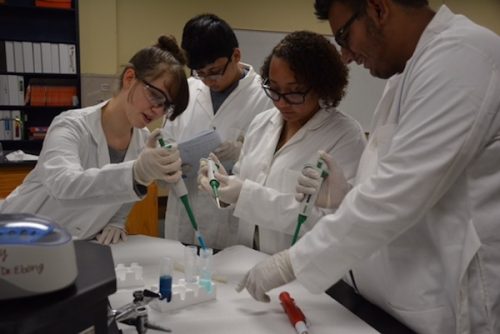
From left to right: Christianna Cosgray -Freshman, Eberardo Rodriguez Esquivel – Junior, Alexandria Coleman – Junior , Jonathan Garcia – Junior
Proposal Summary:
Becoming an astronaut involves rigorous training to prepare for the many challenges they will face during their mission. Astronauts are prepared physically and mentally to overcome obstacles they may face. One aspect that has been neglected in previous research is a thorough study of antibiotic effectiveness. While astronauts typically have exceptional health, it is important to study how antibiotics affect the human microbiome as we progress towards future space exploration and possible colonization of Mars. This experiment can aid in our understanding of how to maintain optimal health of future space explorers following an infection. A common side effect of antibiotic use is the killing of advantageous bacteria in the digestive tract. These beneficial bacteria aids in human digestion. Recent research has examined the effect of antibiotics on the beneficial bacteria within the human microbiome. The microbiome is defined as the symbiotic microorganisms that live in the human body. Approximately 10-100 trillion microorganisms live inside the average human. Recent studies have shown that the micro biome is an integral part of maintaining optimal physical and mental health. However, when a person takes antibiotics, there are changes that occur in the microbial population of the gut. These changes are often associated with mild to moderate digestive distress which may require special probiotic supplements to the individual’s diet. As space exploration continues maintaining optimal physical and mental health of the human population will be of the utmost importance.
HONORABLE MENTION FINALISTS:
Is the amount of Calcium You Need to Create an Action Potential in Microgravity Equal to that on Earth?
Grade 11, Southside High School, Southside Independent School District
Co-Principal Investigators: Robert Hernandez, Isaac Oveido, Sergio Wickliffe
Teacher Facilitator: Christopher Strey
Proposal Summary:
The question we are proposing is if the amount of Calcium you need to create an action potential in microgravity equal to that on Earth. We are looking for the amount of calcium, needed to create a twitch, which ultimately leads to movement of skeletal muscles. Our team is looking at the amount of Calcium needed and the rate of absorption to see which environment will provide the most efficient results. This is important to know so we can regulate the diet of a person in space so they have the ability to move efficiently over long periods of time. Over long periods of time in microgravity muscles start to atrophy, so exercise and diet need to be monitored very closely as we move closer to an age where we are going to need to travel long distances in space. Through our experiment we hope to be able to determine what concentration of Calcium is ideal, and at what rate it absorbs to cause the muscle to twitch. We are more focused on the dietary side, so absorption will lead to a direct route to the muscle so the calcium can directly have an effect on the muscle to prevent the atrophy of muscles. If we see a difference in absorption or overall amount of Calcium concentration needed, we can figure out one day more efficient foods and supplements to take in space for the inevitable long term space travel and even for colonization in varying degrees of gravity.
Growing Kale, Who NEEDS Soil?
Grade 8, J.L. Matthey Middle School, Southside Independent School District
Principal Investigator: Carolyn Olivo
Co-Investigators: Ethan Rodriguez, Richard Stockhammer
Collaborators: Elizabeth Castro, Pedro Ybarra
Teacher Facilitator: Katherine Lujan
Proposal Summary:
We ask, what is the difference of kale growth between Earth soil and our soil substitute Hydrophilic gel under the effects of microgravity? We chose kale because it can grow successfully under three hours of sunlight, does well in cooler climates, has shorter roots, and can also tolerate different types of soil. Kale has high counts of vitamin A and C, with an abundance of protein, which is needed under the effects of microgravity; making it an optimal candidate for space. Hydrogel which is the main star of this project is a super-efficient soil substitute, having the ability to retain large amounts of water, making it ideal to take to space. We hope that the Hydrogel will be a more efficient way to go crops in space. Finding the difference of growth between our Earth soil and Hydrogel would allow scientists to see if hydrogel is adequate or better substitute for soil in space, which could allow for more plant growth in space in a speedier, timely manner. This study can be the foundation of future studies of other vegetables to be grown in a timely matter in space. This study can help with how our astronauts can expand the eating habits when in space and to help with the overall benefits our astronauts can get from kale while in space.
